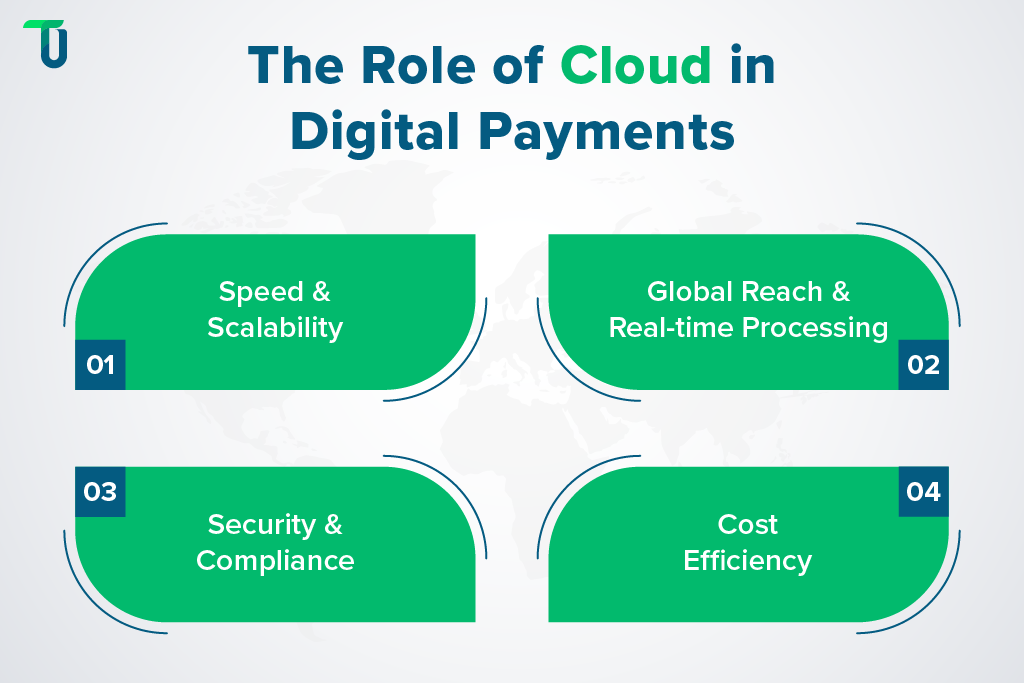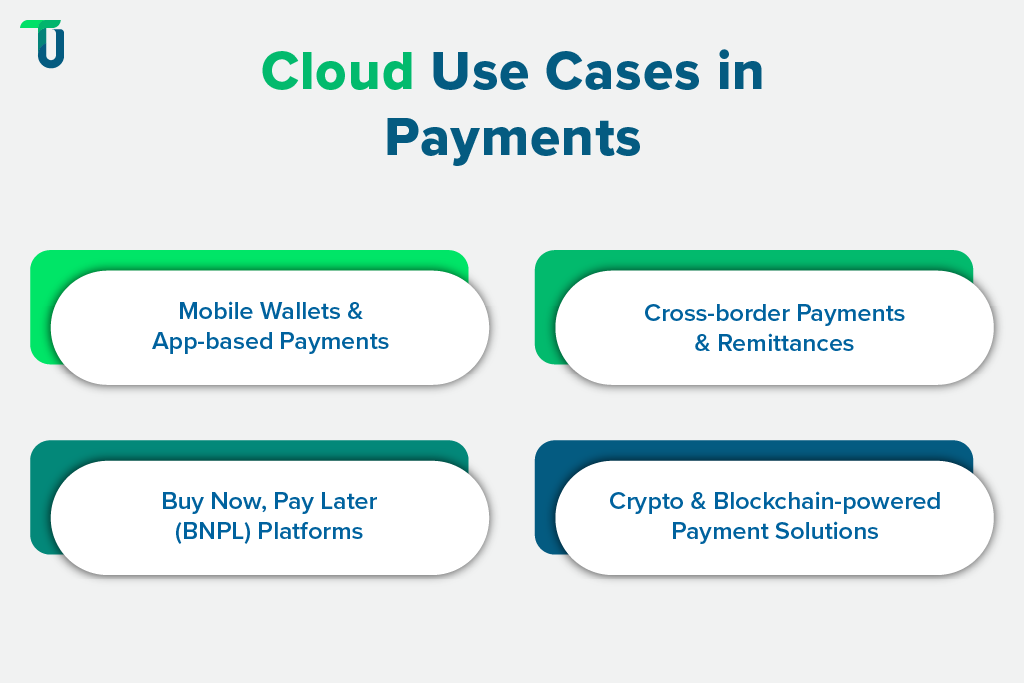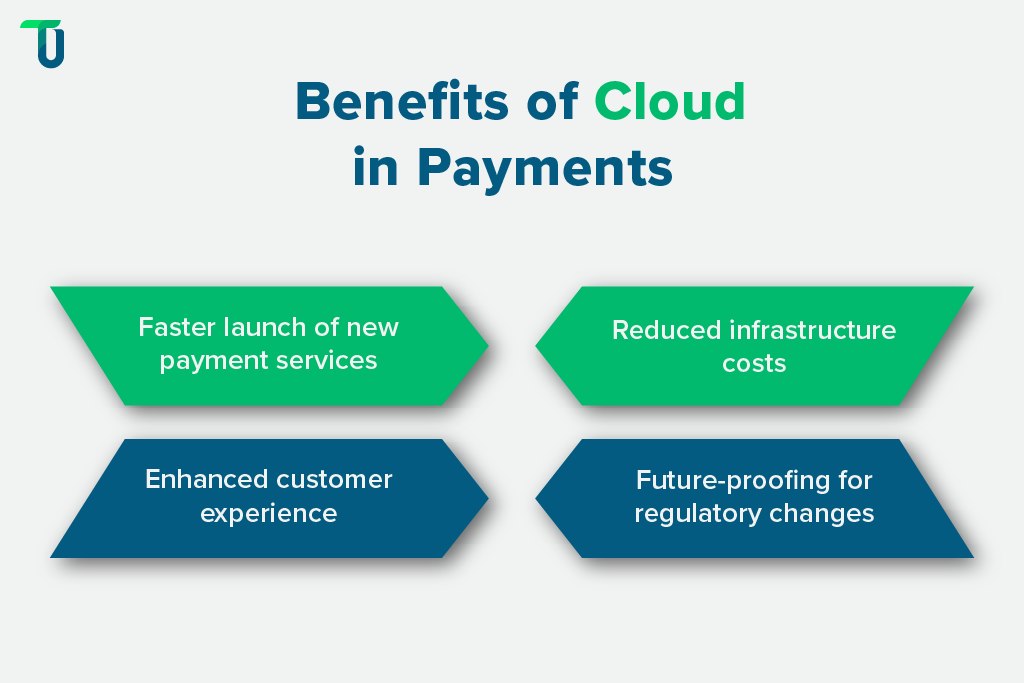What Is Cloud Development in Digital Payments?
At its core, cloud development in digital payments means building and running financial applications on cloud infrastructure instead of relying on on-premise servers. In simple terms, it allows payment providers to process transactions, store sensitive data, and scale services using virtualized resources that can be accessed on demand.
The difference becomes clearer when you compare cloud-native systems with traditional payment infrastructures. Legacy platforms often struggle with fixed capacity, rigid integrations, and expensive upgrades. Cloud-native systems, on the other hand, are designed for elasticity and scalability. They can handle sudden transaction spikes during events like holiday sales or UPI rush hours without downtime, while also making it easier to roll out new payment features in weeks, not months. Learn more about building scalable cloud-based applications to support such high-demand environments.
For fintechs and enterprises, the cloud offers three key consumption models:
- Infrastructure as a Service (IaaS): Virtualized computing, storage, and networking that provide the backbone for payment platforms.
- Platform as a Service (PaaS): Ready-to-use frameworks that speed up development of payment apps without worrying about backend complexity.
- Software as a Service (SaaS): Cloud-hosted applications like payment gateways, fraud detection tools, or BNPL solutions that can be instantly integrated.
Together, these models give payment providers the agility to innovate faster, reduce infrastructure costs, and deliver seamless digital transactions at a global scale, making it crucial to understand choosing the right cloud service model (SaaS, PaaS, IaaS) for their specific needs.
Why Cloud Is Becoming Critical in Payments & Transactions?
The payments ecosystem is now handling billions of transactions every day, from a tap on a smartwatch to a cross-border remittance in seconds. Traditional infrastructure was never built for this scale or complexity, which is why cloud software development has moved from being an enabler to becoming the very backbone of digital payments.

Speed and scalability for high transaction volumes
Peak seasons like festive sales or global shopping events can multiply transaction volumes overnight. Cloud computing development makes it possible to scale infrastructure on demand, so payment systems can handle sudden surges without latency or outages. This elasticity ensures uninterrupted customer experiences, no matter how unpredictable the demand - something made possible by cloud-native applications that offer flexibility and scalability for high-volume transactions.
Global reach and real-time processing
Fintechs and enterprises need to serve customers across geographies while guaranteeing instant settlement. With cloud development services, payment providers can deploy applications closer to users through distributed data centers, reducing latency and enabling real-time payment processing anywhere in the world.
Security and compliance readiness
Regulations like PCI DSS and GDPR compliance in payments, along with local data protection laws, keep evolving. Development in cloud computing offers built-in compliance support, advanced encryption, and continuous monitoring, reducing the burden of managing security manually. Payment companies can rely on cloud-native security layers to protect sensitive financial data while staying audit-ready. In fact, many providers now leverage cloud computing for secure digital transactions, ensuring that payments are protected end-to-end with advanced fraud prevention.
Cost efficiency for fintech startups and enterprises
Building payment systems on-premise demands heavy upfront investments in hardware and ongoing maintenance. With cloud development services, both startups and enterprises pay only for what they use. This lowers operational costs, accelerates innovation cycles, and frees up capital for growth initiatives.
How Cloud Development Powers Digital Payments?
The strength of modern payment systems lies in their ability to be always available, instantly scalable, and secure against evolving risks—something cloud software solutions enhance business agility, enabling seamless high-volume transaction processing for. This is where cloud software development delivers unmatched value, making payments not just digital but truly intelligent and resilient.
On-demand scalability during peak transactions
Holiday rush, flash sales, or UPI spikes can make transaction volumes skyrocket without warning. With cloud computing development, payment systems automatically scale up resources to meet demand and scale down when volumes normalize. This elasticity ensures performance without wasted infrastructure costs.
High availability and disaster recovery
Downtime in payments means lost revenue and damaged trust. Through cloud development services, payment providers can achieve high availability with multi-region deployments and automated failover. Disaster recovery is faster and more reliable, ensuring transactions continue seamlessly even during unexpected outages.
API-first architecture for seamless integrations
Fintech thrives on partnerships: BNPL platforms plugging into e-commerce apps, wallets connecting with banks, or cross-border remittances linking with local payment rails. Cloud software development enables an API-first approach, making it easier to integrate new services and partners quickly without disrupting existing systems.
Data analytics and AI for fraud detection
Every transaction generates valuable data. With development in cloud computing, this data can be processed in real time using advanced analytics and AI models to detect anomalies, flag suspicious activity, and prevent fraud before it happens. The cloud’s computing power ensures these checks happen instantly, not after the damage is done. This highlights the role of cloud in fraud detection for payments, giving fintechs and enterprises the confidence to scale while minimizing risks.
Serverless and microservices for agility
Innovation in payments depends on agility. By leveraging serverless and microservices architecture in fintech, cloud development services allow providers to build modular systems where new features can be deployed rapidly, tested independently, and scaled without re-architecting the entire platform.
Real-World Use Cases of Cloud in Payments
The power of cloud software development becomes clear when you look at how modern payment solutions operate at scale. Whether it is digital wallets, cross-border payments on cloud, or blockchain ecosystems, cloud computing development ensures speed, compliance, and reliability across every transaction.

Mobile wallets and app-based payments
Apple Pay, Google Pay, and PayPal are now embedded in everyday commerce. Their ability to process millions of payments in real time depends on cloud development services, which provide the elasticity and availability to handle peak demand without compromising security.
Cross-border payments and remittances
Traditional international transfers often take days and come with high fees. With development in cloud computing, companies like Stripe, Wise, and Payoneer leverage distributed infrastructure and APIs to deliver near-instant cross-border payments while meeting diverse regulatory requirements across regions. Achieving this reliability often involves applying CQRS and SAGA for distributed transactions to manage complex financial operations seamlessly across multiple services.
Buy Now, Pay Later (BNPL) platforms
BNPL adoption in the US has surged with providers like Affirm and Afterpay. Grand View Research confirms that the North America BNPL Market accounted for the largest, i.e., a 29.3% share of the overall global market valued at USD 9.50 billion in 2024. These cloud-based BNPL platforms rely on cloud computing development to perform instant credit assessments, prevent fraud, and integrate seamlessly with e-commerce checkout flows, all while managing transaction spikes during seasonal shopping events.
Crypto and blockchain-powered payment solutions
From Coinbase to Circle’s USDC stablecoin, crypto transactions demand high-performance infrastructure for blockchain validation, wallet services, and fraud detection. Cloud software development powers these workloads, enabling scalability, resilience, and security as crypto payments continue to move into the mainstream.
These examples prove that the most innovative and trusted names in digital payments already rely on the cloud. For fintechs and enterprises alike, cloud development is no longer optional; it is a strategic enabler for staying competitive in the future of payments.
Benefits of Cloud Development for Digital Transactions
Enterprises and fintechs are under constant pressure to innovate faster, reduce costs, and deliver seamless customer experiences. This is where cloud software development proves invaluable, creating tangible business outcomes that traditional infrastructure cannot match. Among the biggest benefits of cloud development in fintech payments are faster rollouts, lower infrastructure costs, and the ability to handle real-time payments with cloud infrastructure while maintaining security and compliance.

Faster go-to-market for new payment services
Launching a new payment product traditionally required months of setup, testing, and deployment. With cloud development services, providers can build, test, and roll out features in weeks by leveraging pre-built frameworks, APIs, and automated environments. This agility helps businesses stay ahead of consumer demands and competitive pressure.
Reduced infrastructure costs
Owning on-premise infrastructure is expensive and rigid. Cloud computing development replaces capital expenses with a pay-as-you-go model, allowing payment providers to scale resources only when needed. This not only lowers operational costs but also frees up budget for innovation and growth initiatives.
Enhanced customer experience with real-time payments
Customers expect instant payments whether they are splitting a bill, paying for a subscription, or making a cross-border transfer. Development in cloud computing ensures real-time processing with minimal latency, creating frictionless experiences that increase trust and loyalty.
Future-proofing for regulatory changes
Payment regulations are constantly evolving, from data residency requirements to privacy laws like GDPR and CCPA. Cloud software development offers built-in compliance support, flexible data management, and automated monitoring. This helps businesses adapt quickly to regulatory changes without disrupting operations.
Challenges in Cloud-Based Payment Development and How to Overcome Them
While cloud software development is transforming digital payments, adopting it is not without challenges. Enterprises must navigate security concerns, vendor dependencies, and complex regulatory environments. The good news is that with the right strategies, these hurdles can be mitigated to unlock the full potential of cloud computing development.
Data privacy and security risks
Handling sensitive financial data makes payment platforms a prime target for cyberattacks. The challenge lies in protecting this data while maintaining seamless customer experiences.
The solution: Use cloud providers that offer end-to-end encryption, tokenization, and advanced threat detection. Embedding AI-driven monitoring through cloud development services can flag anomalies in real time, reducing fraud risks while ensuring compliance with data protection standards.
Vendor lock-in concerns
Relying heavily on a single cloud provider can create long-term inflexibility and pricing risks. Payment companies fear that shifting providers could disrupt critical operations.
The solution: Build a hybrid and multi-cloud strategy. By designing applications using an API-first approach and microservices, payment platforms can ensure portability and avoid lock-in. Leveraging development in cloud computing with containerization tools like Kubernetes further improves interoperability across providers.
Compliance complexity in different regions
Operating across multiple geographies means managing a maze of compliance requirements, from PCI DSS to GDPR and region-specific data residency laws.
The solution: Partner with cloud development services that provide region-specific compliance support and offer flexible data storage models. Automating compliance checks through cloud-native tools help reduce manual overhead while staying audit-ready at scale. With a thoughtful approach to cloud computing development, payment providers can balance innovation with risk management, ensuring their platforms are secure, agile, and globally compliant.
Case Studies: Leading Payment Companies Using Cloud
Some of the biggest names in payments have already proven the value of cloud software. From improving transaction speed to reducing infrastructure costs and scaling globally, these leaders demonstrate how cloud development services translate into tangible business outcomes. Their success illustrates how cloud application development with microservices can modernize even the most complex financial ecosystems.
Here are four examples that highlight the success of cloud computing.
1. PayPal
PayPal modernized its payment infrastructure by migrating horizontally scalable applications to Google Cloud. This move accelerated operations significantly. What used to take a month on-premises now completes in minutes, and the migration also delivered major cost savings. During pandemic-era and holiday transaction peaks, the cloud shift helped PayPal maintain reliability under soaring demand.
2. Stripe
Stripe has built its entire PCI-compliant payment platform on AWS, ensuring both seamless scaling and robust security. The cloud environment enables developer productivity, real-time monitoring, and smooth scaling across thousands of transactions per second. During high-volume periods like Black Friday and Cyber Monday, Stripe processes up to 13,000 API requests per second, powered by cloud analytics.
3. Square / Block
Square offers a powerful cloud-based POS and payments ecosystem serving millions of US merchants. As a SaaS-first platform, Square’s cloud-native approach fuels mobile accessibility, integrated inventory and invoicing, and seamless updates, making it a leader in point-of-sale systems.
4. Discover Financial Services
Discover migrated major parts of its card settlement and transaction processing infrastructure from legacy on-premises systems to AWS. This modernization boosted transaction processing speed. One day’s worth of settled files now processes in just 1.5 hours, and 4 million transactions complete in under 10 minutes. Pricing change rollout times dropped from six months to just three weeks.
The Future of Digital Payments with Cloud
The next wave of financial innovation will be powered by cloud computing development. What started as an infrastructure choice has become the strategic foundation for everything from fraud prevention to central bank–backed currencies. For fintechs and enterprises, the future is not just digital, it is cloud-first. From payment infrastructure modernization services to secure APIs and CBDCs, understanding the right cloud service model for fintech microservices will continue to reshape the global financial landscape.
AI-driven fraud prevention
As transaction volumes grow, fraud tactics are becoming more sophisticated. Cloud development enables payment providers to deploy AI models at scale, analyzing millions of data points in real time to detect and block suspicious activity before it impacts customers.
Edge computing for instant microtransactions
With IoT devices, connected cars, and subscription-based models, the demand for low-value, high-frequency transactions is surging. Edge-enabled cloud development services, powered by serverless edge computing, process payments closer to the source, reducing latency and enabling true instant microtransactions without relying solely on centralized data centers.
Open banking and cloud-based APIs
The shift toward open banking is redefining collaboration between banks, fintechs, and third-party providers. Through development in cloud computing, open APIs become secure, scalable, and easy to integrate, allowing new payment services and financial products to launch at unprecedented speed.
The rise of central bank digital currencies (CBDCs) on cloud infrastructure
Governments and central banks worldwide are piloting CBDCs to modernize monetary systems. Cloud-native infrastructure provides the scalability, security, and resilience required to support these sovereign digital currencies, making them interoperable with existing payment rails.
The message is clear. The future of payments will be shaped by agility, intelligence, and trust, all of which are made possible through cloud development services. Those who invest early in cloud computing will be best positioned to lead in a market where speed and security define success.
Reimagine Digital Payments with TenUpSoft’s Cloud Development Expertise
The future of payments will not wait. From scaling global transactions to enabling AI-driven fraud prevention, cloud development services are now the key enablers of every serious fintech and enterprise strategy. It's not about whether to move to the cloud or not. What matters is how to do it right?
This is where TenUpSoft makes the difference. We specialize in cloud software development that is built for scale, security, and speed. Our expertise spans cloud-native application development, modernization, API-first integrations, and compliance-ready architectures designed specifically for high-volume industries, like digital payments. By combining deep technical know-how with a consultative approach, we help enterprises:
- Accelerate time-to-market with agile, cloud-native development.
- Optimize costs through scalable, pay-as-you-go infrastructure.
- Ensure trust and compliance with built-in security and regulatory alignment.
- Stay future-ready with solutions that adapt to evolving fintech innovations like open banking and CBDCs.
At TenUp Software Services, we do more than build in the cloud. We help you transform payments into a competitive advantage.
Faster Go-to-Market. Lower Costs. Future-Ready Compliance.
TenUp Software Services has delivered cloud-powered solutions across industries. Yours could be next. Book a consultation now!
Frequently asked questions
How does cloud development reduce the cost of cross-border payments?
Cloud development lowers costs by replacing legacy rails with scalable, pay-as-you-go infrastructure. It cuts intermediary fees, enables faster settlement, and automates payment processing, making cross-border transactions more efficient and affordable for financial institutions.
What is the difference between cloud-based and traditional payment systems?
Traditional payment systems run on fixed, on-premise servers with high upfront costs and limited scalability. Cloud-based platforms use distributed, internet-hosted infrastructure that scales on demand, offers lower entry costs, automatic updates, and anytime accessibility from any device.
Why is cloud development critical for real-time fraud detection in payments?
Cloud development enables real-time fraud detection by using scalable infrastructure and AI models to process massive transaction datasets in milliseconds. It instantly flags anomalies and suspicious activity, offering faster, more accurate protection than legacy systems.
How do microservices and serverless architectures improve digital payments?
Microservices and serverless architectures make digital payments faster, more scalable, and cost-efficient. Microservices let payment functions run independently for greater resilience and agility, while serverless automates scaling and reduces infrastructure costs. Together, they enable flexible, secure, and always-on payment systems.
What role does edge computing play in digital payments?
Edge computing processes payment data closer to the user, reducing latency and enabling near-instant settlements. It strengthens security by minimizing data transfer risks, supports real-time fraud detection, and scales efficiently for IoT-driven and high-volume digital transactions.
How does cloud development enhance cross-border payment speed?
Cloud development cuts settlement times from days to seconds by using distributed data centers and API integrations. It offers 24/7 availability, reduces intermediaries, and automates compliance, enabling faster, more secure, and cost-efficient global payments.
Why are fintech startups adopting cloud-first payment models?
Cloud-first payment models help fintechs scale globally, cut upfront infrastructure costs, accelerate product launches, and leverage advanced security and analytics, enabling rapid innovation and enterprise-level capabilities without heavy IT overhead.
How does AI-powered cloud infrastructure prevent payment fraud?
Cloud-based AI continuously analyzes transaction patterns in real time, flags or blocks suspicious activity instantly, and adapts using machine learning to improve detection accuracy, reduce false positives, and stay ahead of evolving fraud tactics.

